|
Monday, March 3, 2008
Progress Notes
Robert Melville Marshall (photo 01)
was one of the most outstanding citizens of Tuscumbia during the late 1800's when it was
the hub of activity of Miller County due to the commerce brought by river navigation as
well as being the county seat. We already have on our website under the heading
"River Navigation" interesting information about Captain Bob Marshall's role in
Osage River commerce which you can read at the following web address:
http://www.millercountymuseum.org/rivernav.html
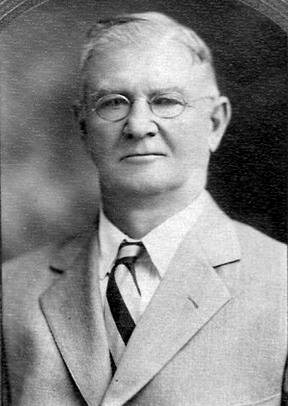
01 Bob Marshall
Because he contributed such an important role to river navigation and commerce as
well as serving as a committed community leader in Tuscumbia, I thought it would be good
to add to our website additional information about his life. I have come across two
newspaper interviews with Captain Marshall published during the middle of the last century
in which he offered extensive quotes and first person accounts of significant interest
that I thought should be made a part of the historical record of our website. These
articles were from the St. Louis Globe-Democrat (January 8, 1950) and the Eldon Advertiser
(September 29, 1949). Also, I have been sent several photographs of Captain Marshall by
Mike Wieneman which I had not seen before Mike sent them. Some but not all I recently
placed on this page but with this narrative I will upload all the photos I have pertaining
to his life and career. First, as usual, I would like to present the very interesting
biography of Captain Marshall written by our much valued historian, Peggy Hake (photo 02 of bio).
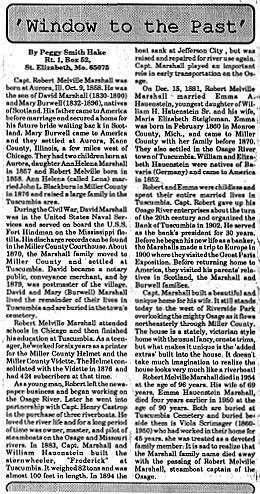
02 Bob Marshall Bio by Peggy Hake
Click on image for larger PDF version
In Peggy's biography she mentioned Captain Marshall's father, David Marshall. The
following is an old obituary from a local newspaper of the time concerning the death of
Captain Marshall's father (I do not know the exact newspaper in which this obituary was
printed. - Photo 03 of obituary)
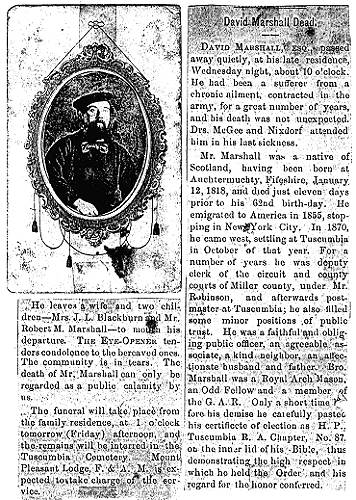
03 David Marshall Obituary
Click on image for larger PDF version
The first of the two interviews of Captain Marshall I mentioned above is presented
here:
Full Head of Steam On The Osage
Clark Vernon
St. Louis Globe Democrat - January 8, 1950
No longer can sharp blasts from steamboat whistles be
heard echoing along the Osage River, as the steamers belched black smoke carrying their
heavy cargo to the important river ports.
There are few old stern wheeler pilots living to
relate their experiences navigating the treacherous waters which once provided a thriving
trade. But this Miller County seat possesses such a citizen who made history on the Osage,
Missouri and Mississippi Rivers.
He is Captain Robert M. Marshall, who, at the age of
91, recalls incidents that would make stories in which Mark Twain would revel. And what a
memory he has. It extends back to the Civil War; to the days when the Indians inhabited
Missouri; to Jesse and Frank James and the Younger brothers; and to President Lincoln's
funeral. These are only a few of the subjects youngsters plead for Captain Marshall to
turn into stories. But the old Captain's chief interest is in the tales of steam
boating---the lingo he knows best. Generally he is known here as "Uncle Bob"-a
salutation signifying endearment among friends, the respect he has won for his
contributions to Tuscumbia's progress, and the esteem of youngsters who share his interest
in the navigation thrills of yesteryear.
A man of short, stocky build, Captain Marshall is a
droll little fellow and, as Tuscumbia folks will tell you, he's as spry as a youngster of
70 (photo 04).
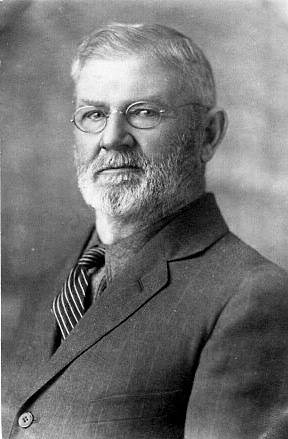
04 Bob Marshall
His thatch of silvery hair is thinning and his
short white whiskers bob up and down as he relates the conditions of Missouri before its
modernization---when daily wages were 35 to 50 cents; when deer and wild turkeys were
plentiful; and when shoes could be purchased for $1.55 a pair, although you had no choice
of style. Cornbread and bacon was the basic meal. Coffee was made from parched wheat and
sweetened with molasses.
Captain Marshall was born in Chicago in 1858, of
parents of Scottish descent. Mention of the family brings an instant reply: "My
Scotch inheritance might have been helpful in my river trades."
He learned the Printer's trade but being a lad with a
yen for adventure found this too confining. He came to Missouri at the age of 12, a few
years after attending President Lincoln's funeral, and made his home at Tuscumbia.
As a young man in 1883 (photo 04a) he bought a half interest in a 100 foot
sternwheeler, the Frederick (photo 05), after quitting his position as clerk in a Tuscumbia store.
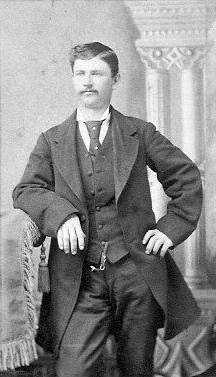
04a Bob Marshall as a young man
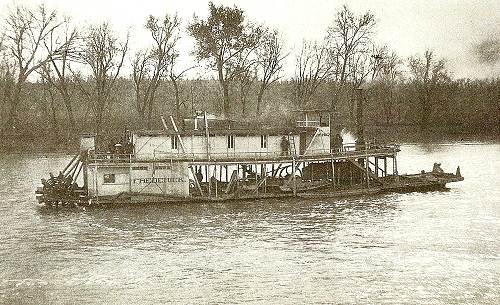
05 Frederick on the Osage
He purchased the John R. Hugo (photo 06),
an Ohio River boat, just five years later and hauled freight and general merchandise over
the rivers that today teem with memories of water traffic.
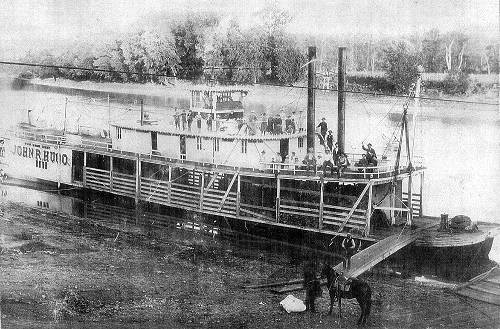
06 John R. Hugo owned by Bob Marshall
For more than 15 years Captain Bob operated
steamboats. Perhaps his most profitable trade was hauling wheat from the lower Osage
River. He recalls transporting more than 200,000 sacks of the grain one year to the
Missouri Pacific Railroad station at Osage City.
Among the early contracts he accepted were one to
deliver 1,000,000 feet of lumber to the Sullivan saddletree factory and another to deliver
2000 cords of wood yearly to the State Prison at Jefferson City at the rate of $2.55 per
cord. The total of $5700 that the old skipper grossed each year for the wood alone was big
money back in the days of low prices. (Today, this wood would sell for about $20,000.)
However, steam boating was not all milk and honey; its
days were 24 hour propositions, with sandbars and hazardous obstacles lurking under the
river's surface to damage the boat in the hands of an unskilled pilot.
"Knowing the rivers" was necessary, and
Captain Bob knew them. Perhaps his most pernicious accident occurred one stormy night when
the Hugo was approaching a railroad bridge over the river at Osage City (photo 07 Osage City Bridge).
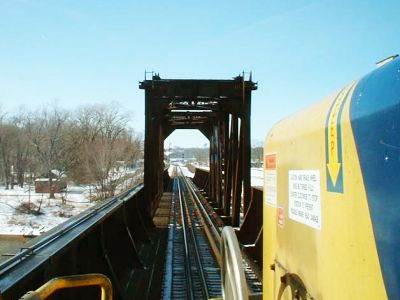
07 Osage City Bridge
He signaled with the steamer's whistle for a
section of the bridge to be raised to permit passage of the tall smoke stacks. Although
the railroad men returned a signal that the bridge was raised, the dark night made it
impossible for the Captain to confirm their reply. When he wheeled the Hugo into what he
thought was the open section, there was a crash, and flames encompassed the pilot house
after the smoke stacks were torn off. Ashore, spectators were near hysteria, thinking the
steamer was sinking with its crew. But the Hugo was only damaged and continued its duty on
the rivers after a few repairs. Captain Marshall never had a boat sink with him, and you
can be sure he's proud of this record.
Can you picture central Missouri back in the
nineteenth century? The old captain can and he's glad to establish the picture in your
mind. Jefferson City (photo 08)
was a town of about 5000 persons a few years after he
came here, with a grocery store, a few buildings and cornfields standing where now are the
congested business district.

08 Jefferson City Downtown - Early 1900's
An unpainted hotel was opposite the spot where
the Central Missouri Trust building is located today and, in place of the Exchange
National Bank was a dilapidated one story saloon with gambling tables much like those seen
in Western thrillers. Later, the Captain hauled gravel from the river, which was used to
transform the main street from a murky thoroughfare.
Little did people realize that modern excavating
equipment and heavy machinery would convert a broad expanse of the Osage River into one of
Missouri's largest power generators---Bagnell Dam at Lake of the Ozarks. The smaller towns
of the state had not yet risen from the wilderness, and many farms were yet being ravaged
by Civil War bushwhackers.
The captain married Miss Emma Hauenstein (photo 09) of
Tuscumbia on December 15, 1881. The ceremony, held in the same house where they now live
(photo 10), was performed by Reverend Hardy, a Methodist minister from
California, Mo., who made the 30 mile trip by horseback.
Marshall.jpg)
09 Bob and Emma (Hauenstein) Marshall
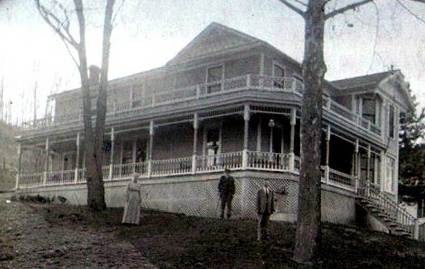
10 Emma Hauenstein, William Henry Hauenstein Sr. & Robert Marshall
The Marshalls are now one of Missouri's oldest
living couples, having observed their sixty eighth wedding anniversary quietly at their
home last month. Mrs. Marshall's two piece beige bridal dress of alpaca trimmed with satin
ribbon and the Captain's black wool suit with swallow tail coat are among their prized
possessions.
Captain Bob secured a heavy freighting business by
aligning himself with the Missouri Pacific Railroad. An agreement was made whereby he was
to deliver all of his freight from the Osage River to the company at Osage City and in
return the railroad was to deliver all Osage River freight to his boat.
Competition was great between railroads and steamboats
and he was given authority by the railroad to make the railroad freight rate from St.
Louis and Kansas City to Osage City.
Once when he went to Kansas City after two carloads of
machinery, he asked the agent to quote a rate to Osage City. "Fifty five cents is the
best we can do," was the reply. The old skipper calmly suggested it be reduced to
twelve and one half cents and the agent was stunned at such an offer. But it was settled
when the Captain told him to contact the general freight agent in St. Louis. The answer
was to lower the rate to Captain Bob's figure.
For six years he worked on the Missouri River for the
government, towing barges to St. Joseph, Omaha, Council Bluffs, Nebraska City and
Plattesmouth. He started this work when the heavy draft of government boats made it
difficult to tow barges over shallow sections of the river. Captain Bob told them the Hugo
could get over the shallow places, so they employed him and the boat.
The craft had a capacity of 2500 sacks of wheat and,
with its barge, the Jumbo, its capacity was doubled, making an equivalent of 16,000
bushels of wheat he could haul at one trip. The government agreed to pay him $40 per day,
rain or shine, and to supply the pilot, deck hands and fuel. He accepted their contract
after calculating that he would net $25 per day.
His health failed as the result of the long hours on
duty and, in 1898, he was forced to retire, although the government asked him to continue
working if possible. After an extended visit to Europe, Captain and Mrs. Marshall returned
here and Captain Bob, taking an interest in civic problems, contributed much to
Tuscumbia's progress in the years that followed. In 1902, he organized the Bank of
Tuscumbia (photo 11) and served as its president for several years.
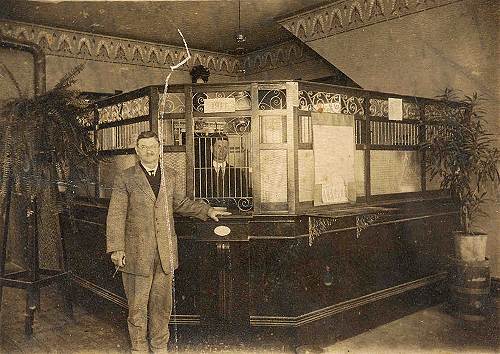
11 Robert Marshall and Fred Fendorf
Seeing a need for a bridge here, he received
approval from the War Department on September 21, 1902, of his plans for a wire suspension
bridge over the Osage River just below Tuscumbia. When the bridge was completed, under his
supervision, it had a channel span of 68 feet above low water, 32 feet above high water
and a horizontal width of 604 feet (photo
12).
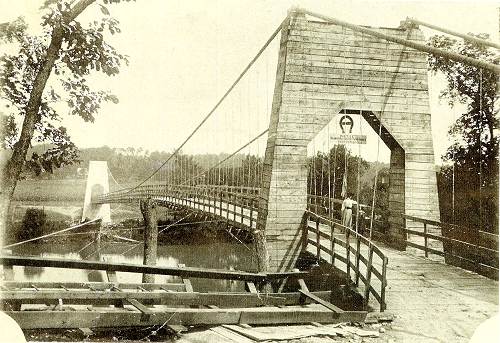
12 Suspension Bridge at Tuscumbia 1905 - 1934
The brick courthouse, located on top of a hill
in Tuscumbia overlooking the river, next caught the eye of the old Captain. This structure
was built it 1858 to replace the old log cabin courthouse (photo 13).
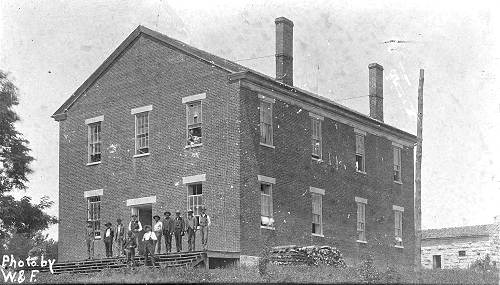
13 2nd Old Courthouse
Captain Bob led the campaign for a better
building and the present stone courthouse was completed in 1910 and is now a Miller County
landmark (photo 14).
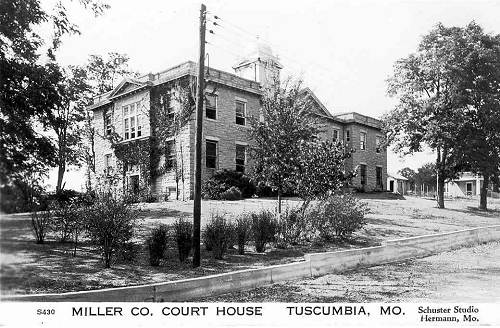
14 Miller County Courthouse
As might be expected, Captain Bobs two story
frame home is perched on a knoll beside the Osage River near the Tuscumbia Riverside Park.
The den on the upper floor is his favorite room, and there he is surrounded by photographs
and souvenirs to remind him of the thrills of steam boating.
The next interview is from the Eldon Advertiser:
Eldon Advertiser September 9, 1949
The river boats no longer ply along the Osage. Bagnell, Warsaw,
Osage City, and such places are not the important river ports that they once were. No
longer do the old sternwheelers race each other into port, the high banks of the Osage
echoing their sharp whistle blasts and the shouts of their crews. But there was a time
when a thriving trade was carried on by steamers plying along the Missouri and the Osage
River. This has changed and now there are few men left who helped to carry on this trade.
Of these few there is one man who is well qualified to speak out
on river boating in the old days. This is Captain R.M. Marshall---Captain Bob as he is
affectionately called around Tuscumbia, Mo., where the 90 year old former steamboat
captain lives. Naturally enough his home is built on a hill near the banks of the Osage
River and there is an unobstructed view of the river.
Captain Marshall will celebrate his 91st birthday October 9,
1949.
In the 80's and 90's perhaps there was not a better known
steamboat skipper along the Osage (photo
15 of young Captain Marshall). Operating and piloting the
Hugo, Captain Marshall also owned another steamboat, the Frederick.
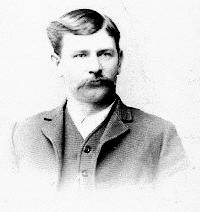
15 Young Captain Marshall
For more than 15 years he operated the boats, hauling
freight merchandise, salt, railroad ties, and wheat on the two rivers.
Born in Chicago in 1858, Captain Marshall lived for a time in
that city. When a boy he learned the printer's trade, but found it too confining.
So in 1870 he came to Tuscumbia, Mo. on the banks of the Osage
River. Here he tried clerking in a store for a few years. Then in 1883, he bought a half
interest in the Frederick. The Frederick had been built the year before by a Tuscumbia
merchant to haul freight from Osage City to Tuscumbia and to take produce to Osage City,
where the railroad was located. Built on the Osage River bank, near Tuscumbia, the
Frederick was 100 feet long and 14 feet wide. It was a stern wheeler.
Captain Marshall did a thriving business with the Frederick and
the Hugo. This latter vessel had been used on the Ohio River. It was 127 feet long, but
while making repairs on it, Captain Marshall decided to increase the length to 141 feet.
In addition to the two steamboats he had a large barge, the
Jumbo.
With the two boats he was able to haul more than 200,000 sacks of
wheat yearly. One year the Hugo delivered 115,000 sacks of wheat to the Missouri-Pacific
Railroad station at Osage City, while the Frederick hauled 90,000 in that same year.
In fact, hauling wheat from the lower Osage River was a good
business for Captain Marshall, perhaps the best of al the trade. He was becoming quite a
successful business man (photo
15a)!
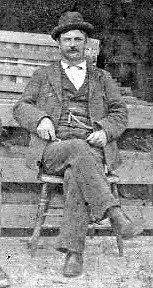
15a Bob Marshall
However, it was not all milk and honey for the river boat
captain. The waters of the Missouri and the Osage were treacherous and difficult to
navigate. Many sandbars made steaming a hazard.
In those earlier days, of course, there were no electric lights
on the steamboats that plied the rivers, and many were the dangers that this caused.
One stormy night when Captain Marshall was approaching Osage City
aboard the Hugo, he had a bad experience. At Osage City it was the practice for a steamer
to whistle so that a section of the railroad bridge could be raised in order to permit the
boat's passage. On this night Captain Marshall signaled to the men in charge to open the
bridge. However, as he approached it, he did not think that it had been opened. The
railroad men replied that they thought it was open and clear. As the night was dark and
there were no lights on the bridge, it was impossible for Captain Marshall to tell whether
this was true. However, he headed for what he thought was the open section. Suddenly, the
Hugo plowed into the upper section of the bridge. The smoke stacks were torn off and flame
surrounded the pilot house.
Along the shore people were shouting and milling around, trying
to get help to save the crew of the Hugo, as they thought that the craft was sinking. Here
again the people on shore were mistaken for the Hugo was damaged but it was never in
danger of sinking.
The steamboat day was 24 hours long, and sometimes Captain Bob
would have to stay up for as long as two days and two nights at a stretch. And this would
occur while navigating through the narrow and often shallow waters of the Osage. During
these long watches he often had a crewman stand beside him with rags soaked in cold water.
At times he would give crewmen orders to speak to him every five minutes.
Another way that he used to keep himself awake during these long
watches was by holding a pipe or pencil between his teeth. If he dropped off to sleep the
pencil would fall to the deck, and its clatter would awaken Captain Bob.
Once the Hugo was stuck on a sandbar for nine days. This was with
a load of 5000 sacks of wheat and some livestock.
Another time the boat was hung on a sandbar near Atchison,
Kansas. This was on the Missouri River about 60 miles northwest of Kansas City. Finally,
the crew managed to float the steamboat.
Sometimes the skipper would have trouble with the crews during
times like these. Most of the crews were obedient, but once in a while they would refuse
to obey the captain of the boat. Most of these river boats carried Negro crews, but
sometimes it was necessary to hire white crews. However, the white crews could not perform
the hard work in the hot sun that the Negroes were able to do. This was brought home
sharply to Captain Marshall on one occasion.
Once when he was unable to get a Negro crew, Captain Marshall
hired a crew of white boys at Tuscumbia. They did well at the start. However, the steamer
stopped at several points along the Osage to pick up sacks of grain. By the time they
reached a particularly shallow section of the river known as Shipley shoals, the Hugo had
4700 sacks of cargo aboard. The water level of the river was falling rapidly and the water
here was shallow. The Hugo stuck fast, and all of the cargo had to be transferred to
Captain Marshall's other steamboat, the Frederick. Loaded onto the other boat in small
numbers the sacks were taken below the stretch of shallow water where they were taken to
shore. Here, they had to be carried by hand and stacked on the banks. This was back
breaking work, but it did the job. As soon as the Steamer Hugo had been relieved of the
cargo it was able to float and the shoals were negotiated without any further trouble. But
when the boat came within sight of the pile of 4700 sacks on the bank of the Osage, the
crewmen decided that they had had enough. They wanted no part of carrying the sacks back
aboard the Hugo. To a man they demanded their pay and quit upon the spot. Captain Marshall
paid off the crew and the men walked back to their homes in Tuscumbia even thought it was
58 miles away. The engineer, foreman and cook were expected to work as roustabouts in
emergencies but Captain Bob waived the rule in this instance. Instead, he took the Hugo
down the river to Osage City where he hired a reliable crew of Negroes. It did not take
them long to reload the Hugo and soon the steamboat was on its way.
In spite of all the difficulties of the river trade it was a
profitable one, and Captain Bob Marshall prospered. He says that one of the reasons he
took up boating on the rivers is because he is a Scotchman. This nationality stood him in
good stead when he had to make deals along the river.
Thus it was not long before he was able to make a very good deal.
This was an agreement with the Missouri Pacific to haul freight from their station at
Osage City to points along the Osage River and the Missouri. By the terms of this
agreement, Captain Marshall received all the freight from the railroad and the Missouri
Pacific got all of his cargoes.
In those days there was as yet no law to restrict the railroad
freight rates. The Missouri Pacific gave Captain Marshall the authority to set the freight
rate for the railroad between Kansas City and Osage City, and between St. Louis and Osage
City.
Captain Marshall made many agreements with the Missouri Pacific
Railroad Company in those days and he says that there never was any violation of these
agreements by the railroad.
Once he went to Kansas City to haul two carloads of machinery for
the railroad. At Kansas City the agent quoted him a rate of 52 cents which Captain
Marshall considered a bit high. He suggested that the rate by changed to 12 ½ cents, but
this the agent refused to do. However, he called the general freight agent at St. Louis
and received the word that Captain Marshall had authority to change the rate. It was
changed.
Later, in the 1890's Captain Marshall made a contract with the
government to haul housing equipment for the Army. This also proved a very profitable
venture for the steamboat skipper. He made many trips along the "Broad Missouri"
towing housing material.
Captain Marshall remembers many tales of exciting happenings
during his days of operating boats along the two rivers. A good one concerns a river pilot
who would not take the skipper's advice. Taken on below Osage City this pilot was
attempting to back the boat. Captain Marshall had advised him to use a bridle, a rope
device designed to keep the rudder straight while backing. Loops fastened to stanchions in
the deck were passed over the spokes of the pilot wheel which was nine and a half feet in
diameter. The pilot scorned the bridle and placed on foot upon a spoke of the huge wheel
to hold it steady as he backed. Captain Marshall was not in the pilot house at the time.
Suddenly he heard a crash in the pilot house and shortly afterward a member of the crew
ran in and told him that there had been an accident in the pilot house. The skipper
reached the pilot house on the double. When he entered he found the pilot hanging by his
head from the overhead or roof. He had on a high hard hat and this had been jammed down
tight over his head. He had been thrown by the twisting wheel and his head complete with
hard hat, was jammed into a small window in the overhead. Captain Marshall pushed him
aside and righted the wheel placing the much needed bridle on it thereby taking the
tension off the pilot so that he could be pulled down from the window, although certainly
not without having suffered some painful injuries.
In 1898 Captain Marshall's health became poor and he had to
retire from boating on the river. The rough work and continuous hours of going without the
normal amount of sleep had begun to tell. During these last few years on the river he had
been doing much work for the government and their officials wanted him to continue,
however, his health would not permit it.
Two years later, in 1900, Captain and Mrs. Marshall took a trip
to Europe. He wanted to see Scotland particularly because his people had come from that
country. It was one of the most pleasant visits during his trip. They also visited
England, France, and Holland. The winter of 1900 they spent in Germany near the Rhine.
This was the locality from which Mrs. Marshall's people, the Hauensteins, had come.
When the Marshalls returned to the Osage they lived in Tuscumbia.
Captain Bob then went into business. He organized the Bank of Tuscumbia in 1902 (photo 16). It was a
success and he was president of the bank for many years.
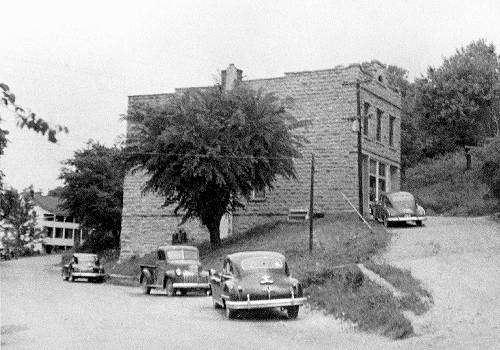
16 Bank of Tuscumbia
Two years after he organized the bank, Captain Marshall
organized a bridge company and later superintended the building of a wire suspension
bridge across the Osage River at a point not far below Tuscumbia (see photo 12 above).
However, some of Captain Marshall's most exciting and interesting
days were spent as a skipper in the river trade, and it would not do to forget some of the
happenings in those times.
"One thing that made the river trade so important was the
great need for it," the old skipper, now 90 years old, says. "The people
depended upon it for supplies and to get their crops out. When we first started there were
no railroads to do this so it all depended on the river boats."
In fact these rivers were used as avenues of communication for
many years before the steamboats came. Where Bagnell Dam and the Lake of the Ozarks now
are, the Osage River once flowed. Even before the white man came to this country Indians
paddled their canoes up and down the Osage River. The Lake region was once inhabited by
powerful Osage tribes and many of them used the river as a road.
When white men came to what is now Missouri they traveled along
the Osage. Early French explorers pushed up the river in Indian canoes. Later the flat
boat came into being and this was an important change since it meant that larger cargoes
could be carried by the settlers.
Captain Bob recalls one race with a St. Louis boat. This happened
on the Osage River and was a close affair. The St. Louis boat was faster and bigger, but
Captain Bob knew the river better. Where the water was deep and the channel wide the St.
Louis steamboat would gain on the Hugo, but when the channel narrowed down and the water
became shallower the advantage was all with Captain Bob.
The race continued like this for the 25 miles to Osage City. When
they were within five miles of that town Captain Bob blew his whistle for the bridge to
open. It opened and Captain Bob's Hugo went through just ahead of the St. Louis boat.
The former steamboat captain likes to talk about the old days
along the river. To us today this is just an interesting phase of the country's history,
but it must have been an exciting one. In fact, a talk with Captain Bob Marshall would
convince anyone that steam boating on the river would be worth taking a crack at. It is
too bad that this mode of travel and commerce, so romantic and adventurous, can only be
imagined today as we look upon the beautiful Osage River, which continues to wind its way
to the Missouri as it has for thousands and thousands of years.
As noted above, after Captain Marshall sold his steamboats he started the Bank of
Tuscumbia in 1902. After thirty years of banking he spent his retirement years in
Tuscumbia living in the same house in which he was married. In 1931 he celebrated his
fiftieth wedding anniversary with his wife, Emma Hauenstein, daughter of William
Hauenstein Sr. This celebration was quite an affair being attended by nearly one hundred
friends and relatives. Copied below is the Autogram article giving the details of the
event. Many Tuscumbians will recognize the names of some of their relatives from long ago (photo 17).
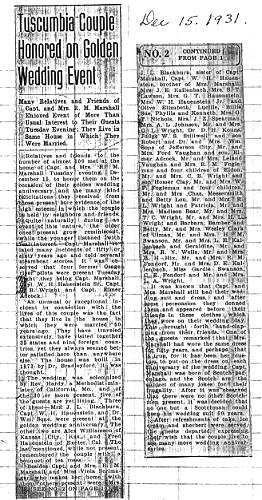
17 Marshall Golden Wedding
Click image for larger PDF version
One of the enduring reminders of Captain Marshall is the sign at the entrance to
the road to the ball park in Tuscumbia the land of which was donated by Captain Bob (photo 18 and photo 18a).
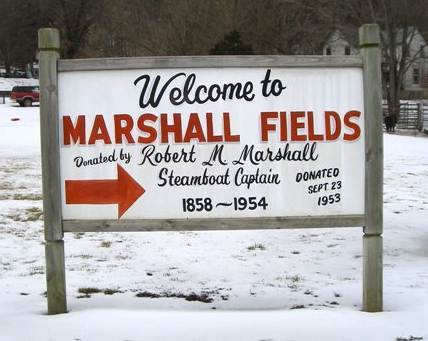
18 Captain Marshall Field Sign
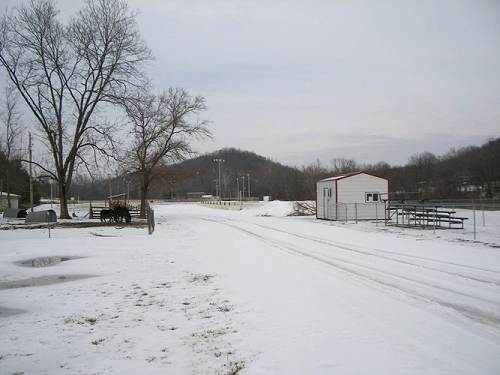
18a Marshall Field
Quite a few people are still living who remember Bob Marshall… for one
reason because he lived so long. My mother, who was raised in a home very close to the
Marshalls in the Goosebottom area of Tuscumbia, remembers Captain Bob always took a walk
every morning up to town to the post office. He was a quiet and reflective person and not
prone to verbal excess during his later years according to her. Although his "Bank of
Tuscumbia" no longer carries that particular name having been purchased by Central
Bank years ago, the bank has been very respectful in remembering Captain Marshall as its
founder in Tuscumbia; you will find hanging on the wall in the bank a large photo of the
Captain looking down eagerly awaiting his friends and customers for the day. You may
remember reading in one of the articles above that Captain Marshall spent the first few
years of his life in Chicago where he was born and that he attended the funeral of Abraham
Lincoln with his father. I think it is amazing that my mother (as well as quite a few
other people today) knew someone who would have attended Lincoln's funeral.
Bamber Wright (photo 19) is one of
our historical society members whose grandfather, William Hauenstein Jr., was a brother in
law of Bob Marshall, since Captain Bob had married William's sister, Emma Hauenstein.
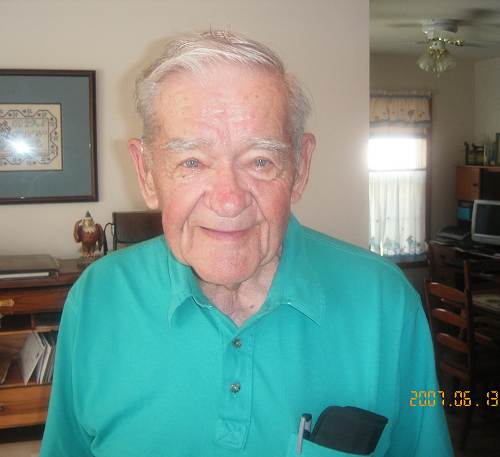
19 Bamber Wright - June 13, 2007
Bamber's great grandfather, William Hauenstein Sr., was the one who had built the
house in which the Marshalls lived. Bamber said that the senior Hauenstein spent the last
few years of his life living with the Marshalls. William Hauenstein Sr., Bamber's great
grandfather, died before he was born so he never met him. However, Bamber was raised in
the home next door to the Marshalls where his parents, Homer Lee and Elizabeth (Lizzie)
Hauenstein Wright, lived. This home (photo 20)
was built by Bamber's grandfather, William Hauenstein Jr. who also lived there.
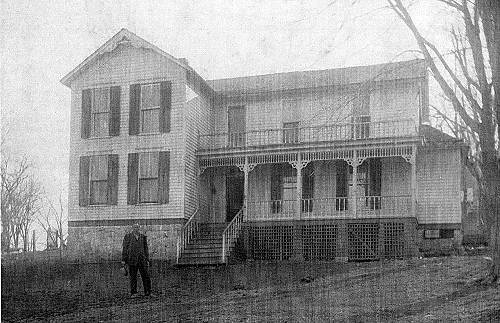
20 W.H. Hauenstein Home
Because of the proximity, Bamber says he was in the Marshall home about every
day. At this time, Captain Bob, who was Bamber's great uncle, had retired. Bamber
remembered that his uncle Bob spent a lot of time in an upstairs room which had a large
library connected to the Marshalls' master bedroom. When he was older and in high school,
Bamber says that everyday he would go upstairs to the library and read the "Jefferson
City paper" while his uncle Bob took a nap.
Bamber remembered that his uncle Bob usually dined alone. He wasn't sure, but he thinks
this was because in his later years, Captain Bob had a tremor and this may have caused him
some difficulty with his eating utensils, for which reason he preferred to be unobserved
while dining.
Often times, Uncle Bob would be found in the late afternoon of a warm spring day
sitting on the large wrap around porch of his home. Bamber remembers that frequently he
would spend time sitting with Uncle Bob on the porch conversing.
Bamber says that Uncle Bob was one of the first in town to have a motor car. During
Bamber's childhood, the car was usually a Buick. However, the last car the Marshalls
bought was a 1942 Dodge. Sometimes Uncle Bob would let Bamber chauffeur him in the car to
visit his farms along the river. Bamber says he was the only one besides Uncle Bob who
ever drove it. Emma, Uncle Bob's wife, and their maid, Viola Scrimmager, sometimes would
make a trip to Jefferson City to shop as well as visit Emma's nephew, Dr. Will Sone, who
was a dentist. Uncle Bob would go to the barn (which was built close to the river bank in
what is now the city park) to get the car and would park it in front of the house and
start honking the horn. Bamber wondered if that urge to honk the horn came from Captain
Marshall's time as a river boat captain when he would blow the whistle frequently as he
traveled up and down the river.
Dr. Sone's mother, Carolyn, was Emma's sister. Unfortunately, she died during
childbirth so Dr. Sone never knew her. Informally, Carolyn was known as "Lena."
Bamber says that name really was a shortened form of the German form of Carolyn, Karoline,
and was probably used since her father, William Hauenstein Sr., was from Germany. Bamber
says that Will's father had been sheriff of Cole County and the story was told that he and
Will's mother actually eloped using a ladder to reach the second story of the house to
allow Lena to leave unnoticed.
In his later years, shortly before his death, Captain Marshall, according to Bamber,
moved to Eldon to live with his niece, Vivian Fogleman Caldwell. Vivian was the daughter
of John and Augusta (Hauenstein) Fogleman (photo
21 and photo 22). Augusta
was a sister to Emma, Captain Bob's wife.
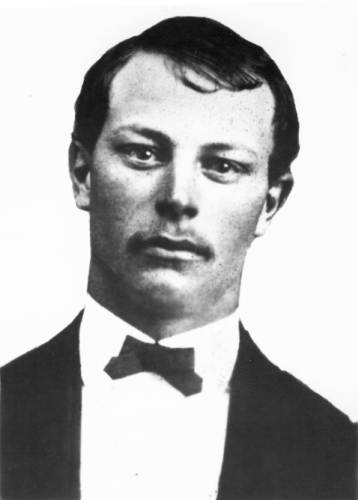
21 John Wilson Fogleman - b. 1851
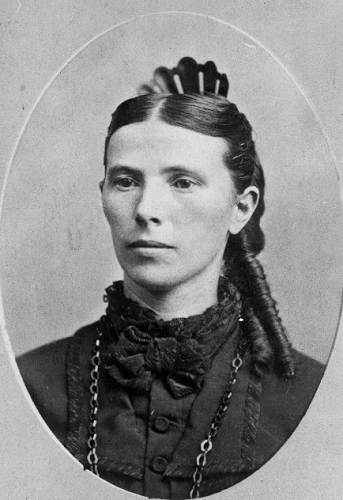
22 Augusta Hauenstein Fogleman - Early 30's - Mother of Vivian Fogleman Caldwell
Finally, for completeness, here are the obituaries of Captain Robert Marshall and
his wife Emma Hauenstein Marshall:
Miller Co. Autogram
September 9, 1954
Steamboat pilot, Robert Marshall, Dies Wednesday
(September 8, 1954)
A former Osage River steamboat captain and prominent
Tuscumbia citizen, Robert M. "Uncle Bob" Marshall, 95, died Wednesday morning at
the home of Mr. and Mrs. Charles M. Caldwell in Eldon.
Mr. Marshall spent 20 years on the Osage River as a
steamboat pilot and became known as "Captain" on his numerous river trips. He
was manager of the Osage and Missouri River Packet Co.
Until his retirement in 1932, he was president of the Bank
of Tuscumbia. He also had been president of the Anchor Milling Co. at Tuscumbia and was a
member of a group which promoted the building of the first bridge across the Osage near
Tuscumbia. The Riverside Park property was donated by Captain Marshall.
"Uncle Bob" was born on Oct. 9, 1858 at Aurora,
Illinois. He moved to Miller County in 1870 and settled at Tuscumbia with his parents. He
attended school there and worked as a printer before steam boating became his trade.
He has resided with Mr. and Mrs. Caldwell for
approximately four years. Funeral services will be at 2 p. m. on Friday at the Tuscumbia
Presbyterian Church under the direction of Phillips Funeral Service.
Miller Co. Autogram
July 20, 1950
Mrs. Emma A. Marshall, 90, last surviving member of one of
Miller county's pioneer families died at the family home in Tuscumbia, July 12th, 1950
after a lingering illness. She had been an invalid for the past three years.
Funeral Services were conducted at the Presbyterian Church
in Tuscumbia, Thursday afternoon at 2: 00 o'clock by the pastor, Rev. James Duncan. Burial
was in the family lot at the Tuscumbia Cemetery under direction of Phillips Funeral
Service.
Born at Newport, Michigan, February 9, 1860, Mrs. Marshall
was the daughter of William H. Hauenstein, Sr. and Elizabeth Hauenstein. In 1865, she
moved with the family to Tuscumbia where she lived until her death.
On December 15, 1884, she was married to Capt. R. M.
Marshall at the family home where they have since resided.
She was one of a family of six children, all of whom
preceded her in death. They were William H. Hauenstein and Phillip F. Hauenstein,
brothers; and Augusta Fogleman, Lena Sone and Elizabeth Hauenstein, sisters. She was also
preceded in death by Miss Viola Scrimager, who made her home with the Marshall family for
45 years.
Mrs. Marshall became a member of the Tuscumbia
Presbyterian church November 20, 1889. Until illness prevented, she devoted much of her
time to the church and community affairs.
Besides her husband, Capt. Marshall, she is survived by
several nieces and nephews.
We are looking forward to hosting the Leadership Miller County group this next
Thursday, March 6 for a luncheon and tour of the museum. The organization was created by
Miller County leaders along with the Eldon Chamber of Commerce, Lake Area Chamber of
Commerce and the University of Missouri Extension to encourage and motivate citizens of
Miller County to become involved in community affairs by improving the skills they require
to assume leadership responsibilities for the betterment of the community. For more
information about this group you can call the extension office located at Tuscumbia at 573
369 2394, email: millerco@missouri.edu,
or visit their website at: http://extension.missouri.edu/miller
That concludes this week's Progress Notes.
| 


